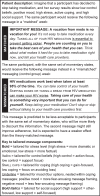A counselor in your pocket: feasibility of mobile health tailored messages to support HIV medication adherence
- PMID: 26491263
- PMCID: PMC4599065
- DOI: 10.2147/PPA.S88222
A counselor in your pocket: feasibility of mobile health tailored messages to support HIV medication adherence
Abstract
Purpose: Medication adherence is a major challenge in HIV treatment. New mobile technologies such as smartphones facilitate the delivery of brief tailored messages to promote adherence. However, the best approach for tailoring messages is unknown. Persons living with HIV (PLWH) might be more receptive to some messages than others based on their current psychological state.
Methods: We recruited 37 PLWH from a parent study of motivational states and adherence. Participants completed smartphone-based surveys at a random time every day for 2 weeks, then immediately received intervention or control tailored messages, depending on random assignment. After 2 weeks in the initial condition, participants received the other condition in a crossover design. Intervention messages were tailored to match PLWH's current psychological state based on five variables - control beliefs, mood, stress, coping, and social support. Control messages were tailored to create a mismatch between message framing and participants' current psychological state. We evaluated intervention feasibility based on acceptance, ease of use, and usefulness measures. We also used pilot randomized controlled trial methods to test the intervention's effect on adherence, which was measured using electronic caps that recorded pill-bottle openings.
Results: Acceptance was high based on 76% enrollment and 85% satisfaction. Participants found the hardware and software easy to use. However, attrition was high at 59%, and usefulness ratings were slightly lower. The most common complaint was boredom. Unexpectedly, there was no difference between mismatched and matched messages' effects, but each group showed a 10%-15% improvement in adherence after crossing to the opposite study condition.
Conclusion: Although smartphone-based tailored messaging was feasible and participants had clinically meaningful improvements in adherence, the mechanisms of change require further study. Possible explanations might include novelty effects, increased receptiveness to new information after habituation, or pseudotailoring, three ways in which attentional processes can affect behavior.
Keywords: HIV; adherence; communication; feasibility; technology.
Figures



References
-
- Chesney MA. The elusive gold standard: future perspectives for HIV adherence assessment and intervention. J Acquir Immune Defic Syndr. 2006;43(Suppl1):S149–S155. - PubMed
-
- Christensen AJ. Patient Adherence to Medical Treatment Regimens: Bridging the Gap Between Behavioral Science and Biomedicine. New Haven: Yale University Press; 2004.
-
- Paterson DL, Swindells S, Mohr J, et al. Adherence to protease inhibitor therapy and outcomes in patients with HIV infection. Ann Intern Med. 2000;133(1):21–30. - PubMed
-
- Amico KR, Harman JJ, Johnson BT. Efficacy of antiretroviral therapy adherence interventions: a research synthesis of trials, 1996 to 2004. J Acquir Immune Defic Syndr. 2006;41(3):285–297. - PubMed
-
- Noar SM, Benac CN, Harris MS. Does tailoring matter? Meta-analytic review of tailored print health behavior change interventions. Psychol Bull. 2008;133(4):673–693. - PubMed
Grants and funding
LinkOut - more resources
Full Text Sources
Miscellaneous

